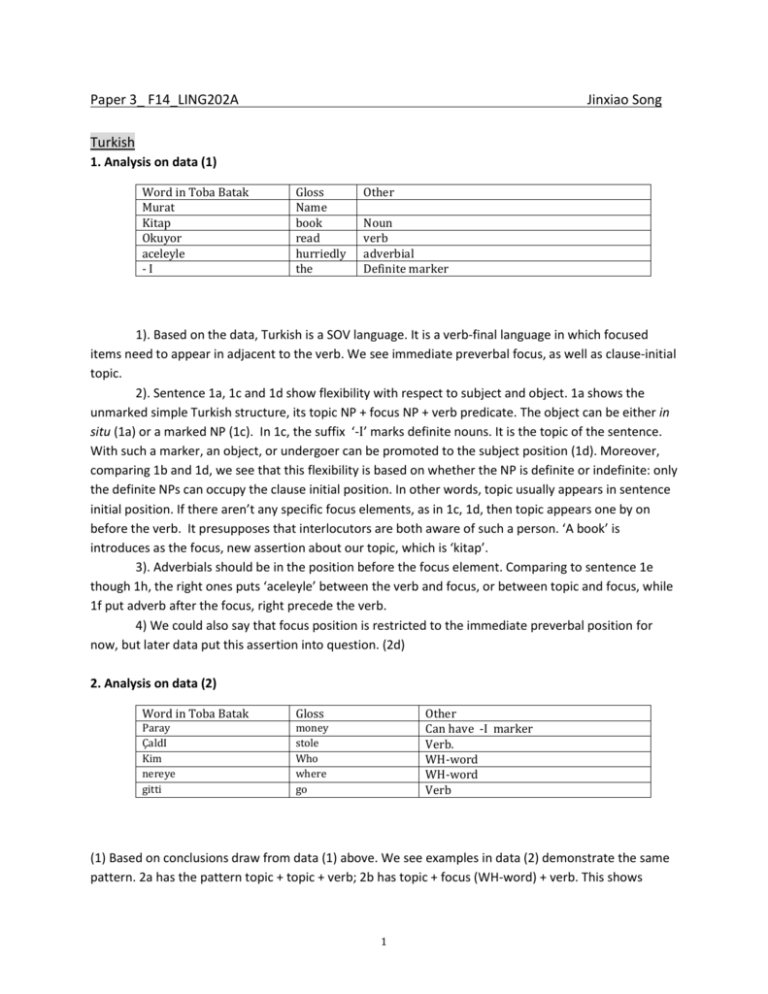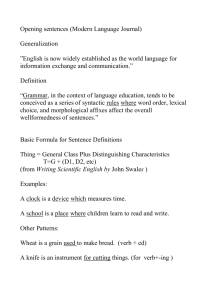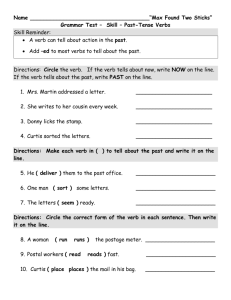Paper 3 - WordPress.com
advertisement

Paper 3_ F14_LING202A Jinxiao Song Turkish 1. Analysis on data (1) Word in Toba Batak Murat Kitap Okuyor aceleyle -I Gloss Name book read hurriedly the Other Noun verb adverbial Definite marker 1). Based on the data, Turkish is a SOV language. It is a verb-final language in which focused items need to appear in adjacent to the verb. We see immediate preverbal focus, as well as clause-initial topic. 2). Sentence 1a, 1c and 1d show flexibility with respect to subject and object. 1a shows the unmarked simple Turkish structure, its topic NP + focus NP + verb predicate. The object can be either in situ (1a) or a marked NP (1c). In 1c, the suffix ‘-I’ marks definite nouns. It is the topic of the sentence. With such a marker, an object, or undergoer can be promoted to the subject position (1d). Moreover, comparing 1b and 1d, we see that this flexibility is based on whether the NP is definite or indefinite: only the definite NPs can occupy the clause initial position. In other words, topic usually appears in sentence initial position. If there aren’t any specific focus elements, as in 1c, 1d, then topic appears one by on before the verb. It presupposes that interlocutors are both aware of such a person. ‘A book’ is introduces as the focus, new assertion about our topic, which is ‘kitap’. 3). Adverbials should be in the position before the focus element. Comparing to sentence 1e though 1h, the right ones puts ‘aceleyle’ between the verb and focus, or between topic and focus, while 1f put adverb after the focus, right precede the verb. 4) We could also say that focus position is restricted to the immediate preverbal position for now, but later data put this assertion into question. (2d) 2. Analysis on data (2) Word in Toba Batak Gloss Paray ÇaldI Kim nereye gitti money stole Who where go Other Can have -I marker Verb. WH-word WH-word Verb (1) Based on conclusions draw from data (1) above. We see examples in data (2) demonstrate the same pattern. 2a has the pattern topic + topic + verb; 2b has topic + focus (WH-word) + verb. This shows 1 Turkish WH-word can naturally appear in situ. Comparing 2b with 2b’ and 2b’’, we can see that if a sentence has focus NP and topic NP, then the topic goes before the focus. However, 2b’ and 2b’’ put WH word in the sentence beginning topic position. (2) 2c and 2c’’ confirms that idea that adverbials need to appear before the focus. Besides, it can be omitted (in parenthesis) in sentence 2c, 2d. (3) WH- word does not appear clause initial. As in 2b, 2b’’ and 2d’, as well as 2e vs 2e’. We do not see WH word appear in the beginning of a sentence, unless there is another focus after it. (2d) has the WH word sentence initial, but actually we see this is based on the existence of the topic ‘babkadan’. I think the parenthesis means the topic, which is presupposed by interlocutors. Therefore 2d has two focus elements, one is ‘who’, and another is ‘some money’. Its right to put WH-word before the actual focus ‘money’, but not the other way around. 3. Analysis on data (3) (1) 3a shows a completive narrow focus on clause final NP. Besides, 3a and 3b confirm that topic position is clause-initial, with focus (yeni bardak-la ‘with the new glass’) immediate preverbal in 3a-Q. (‘baba-n-a sarab-I, the wine for your father’ is the topic, it can be omitted in the answer. ) (2) The odd answer in 3a-A’ suggests that the narrow focus is not clause initial. It is not the ‘father’ that is being focused. (3) 3b reflects the same focus structure, but this time changing the focus to ‘uncle’, which is put in situ before the verb. The hashed response focuses on ‘amcana, uncle’ is an odd answer, given the focus on ‘bardakla’, as is 3bA’ in response to 3b.Q. The focus structure of the clause makes the hashed responses a mismatch in terms of the question’s focus. 4. Analysis on data (4) 4b, 4c, and 4d confirm that the topic position is clause-initial, with the focus position preverbal, after the topic, and adverbials. But given examples 2d and 4b, 4c, and 4d, It seems the potential focus domain indeed needs to encompass more than just the immediately preverbal position. I read about the following description: ‘Turkish is an in situ focusing language. Thus, contrary to the traditional view, there is no focus position in Turkish where items have to move in order to be focused.’ [1] Conclusion: (1) ‘-I’ marks narrow focus of a sentence. (2) Turkish put subject in sentence beginning, and put predicate at the end. Focus has to be adjacent to the predicate, especially for unmarked nouns. Marked (-I) nouns do not need to be immediately preverbal; it can also be in clause initial position. (3) Adverbials appear after the subject. (4) Basic focus structure is: Topic- Focus - Verb PRED (5) WH- word does not appear clause initial without having a topic preceded Focus structure of 3a[Q] [1] Kural, M. (1992). ‘Properties of Scrambling in Turkish’. Ms., ver. 1, UCLA. 2 3 2 .Toba Batak Toba Batak is a VOS language. It has a combination of rigid syntax and rigid focus structure; It’s unmarked word order is comment-topic, and the unmarked focus position is immediately following the verb. The subject position that is following the focus position may be topical or focal. The default is for the subject position to be topical. Word in Toba Batak Man- jaha Buku guru di- jaha i ise aha Man-gida di-ida imana do Gloss read book teacher read the who what see see him Other Verb; ‘man-’ marks simple tense or simple voice noun noun Verb; passive voice or past tense Definite article, appears after noun. verb Verb; passive voice or past tense Pron. particle 1. Data set (1) (1) ‘guru i’ with the word ‘i’ represents definite NP. NP with ‘i’ marker following should be considered as topic. Nouns can appear as indefinite NP topic such as ‘buku’ and ‘guru’ in sentence 1a’, but also as definite NP ‘guru i’ in sentence 1a. Comparing 1a through 1a’’’, we see that the NP immediately following the verb is preferentially interpreted as indefinite and non-specific. Sentence (a’’) and (a’’’) indicate that a definite NP in the immediate post-verbal position is not preferred. (2) Although topic indefinite NP can appear in the sentence final position, this indefinite NP must be interpreted as a referential phrase. As is shown in sentence (a’). ‘Guru’ needs to be understand as ‘a certain teacher’, rather than simply ‘a teacher.’ (3) In sentences 1b through 1b’’’’, we see the same verb for ‘read’ surfaced as ‘dijaha’, different from the previous ‘manjaha’. I think ‘Di-’ can be seen as a passive voice particle, because it correlates with the occurrence of the undergoer being promoted to subject position (which is sentence final position in this case). For example: Actor,agent Undergoer, Patient 1b. Di - jaha guru buku i Passive- read a teacher book DEF A teacher read the book. Undergoer,patient Actor, agent 1a. Man-jaha buku guru i Active - read a book teacher DEF The teacher read a book. 4 In sentence 1b, subject ‘guru’ appears as the undergoer and patient, comparing to sentence 1a’ to 1a’’’, in which ‘guru’ all appear as actor and agent. Although we cannot prove ‘-di’ to be the passive marker, there is a good reason to use such a concept to look at the actor-undergoer shift. Later examples also show this kind of shift. For example: focus Actor, agent, topic 2c. Man - jaha aha guru i Passive- read what teacher DEF What did the teacher read? Actor, agent focus 3a. Di-jaha guru aha? Active - read a teacher what What did a teacher read? These two sentences are given as correct sentences. We see that the focus is always WH-word, It can be put in either in sentence final or before sentence topic. This difference is again accompanied by different verb prefixes. (4) Sentence group 1b—1b’’’ is basically the same construction with group 1a—1a’’’ The unacceptability in sentence (b’’) and (b’’’) also have the same problem with sentence (a’’) and (a’’’). The sentences has to be better follow ‘verb-focus-topic’ sequence, namely the sentence should be better looks like ‘ verb + Indefinite Noun. + Definite Noun’ 2. Data set (2) Sentence 2a, 2b are two sentences with the same meaning. They indicate that the WH- word can function as subject and focus while preceded to a left detached position. For example, in sentence 2a, ‘who’ (‘ise’) appears in situ. It appears in the subject position. Then in sentence 2b, ‘Who’ (‘ise’) appears in a left detached position. If the WH-word functions as the direct object as in sentence 2c and 2d, then it should be in situ. If put the WH-word in left detached position, then the subject position can only be a focus but not a topic. It seems that when people say ‘Wh-word’ ahead, they would be waiting for a focused noun as the narrow focus of the question. 3. Data set (3) Sentence 3a and 3b show similar constructions as sentence 2a and 2b. WH-word can occur in the subject position in sentence 3a, or it can occur in a left detached position (or clause-initial position) in sentence 3b. When comparing sentence 3c with 3d, we can see that when the WH-word want to function as an actor, it must occur in situ in the immediate post-verbal position under passive construction. When comparing 3a with 3c: Agent, actor ,subject object, focus 3a. Di-jaha guru aha? Active - read a teacher what What did a teacher read? Focus,subject undergoer,object topic 3c. Di - jaha ise buku i Passive- read who book DEF Who read the book? 5 Sine the Di- prefix changed the position of actor and undergoer, subject and object. These two sentences have similar underlying constructions, with WH-word in different positions. 3a is literally translated as ‘Teacher read what?’ 3c is literally translated as ‘Who read the book?’ So we see here if WH words are put in the subject, actor position, it has to be followed by definite noun. If ‘WH-word’ is put in situ, in a passive construction, it has to follow an indefinite noun. 4. Data set (4) and data (5) Sentences in data (4) show the limited omission of arguments in discourse. When answering ‘yes/no’ question like sentence 4a, it is acceptable to omit the subject (sentence 4b), which is in the clause final position, but never the immediately post-verbal NP, which is ‘imana’ in sentence 4c. Similarly, the omission phenomena in data set (5) parallel those in data set (4). Only the clause final NP can be omitted, but not the immediate post-verbal NP. Conclusion: Toba Batak present a rigid VOS word order with strong comment-topic tendency in terms of focus structure. However, the WH-word is an exception. WH-words can occur in situ and do not need to be moved to preverbal position every time. The focus structure of Toba Batak is Verb PRED + NP focus + NP topic/focus. 5. Focus structure of 3c 6









